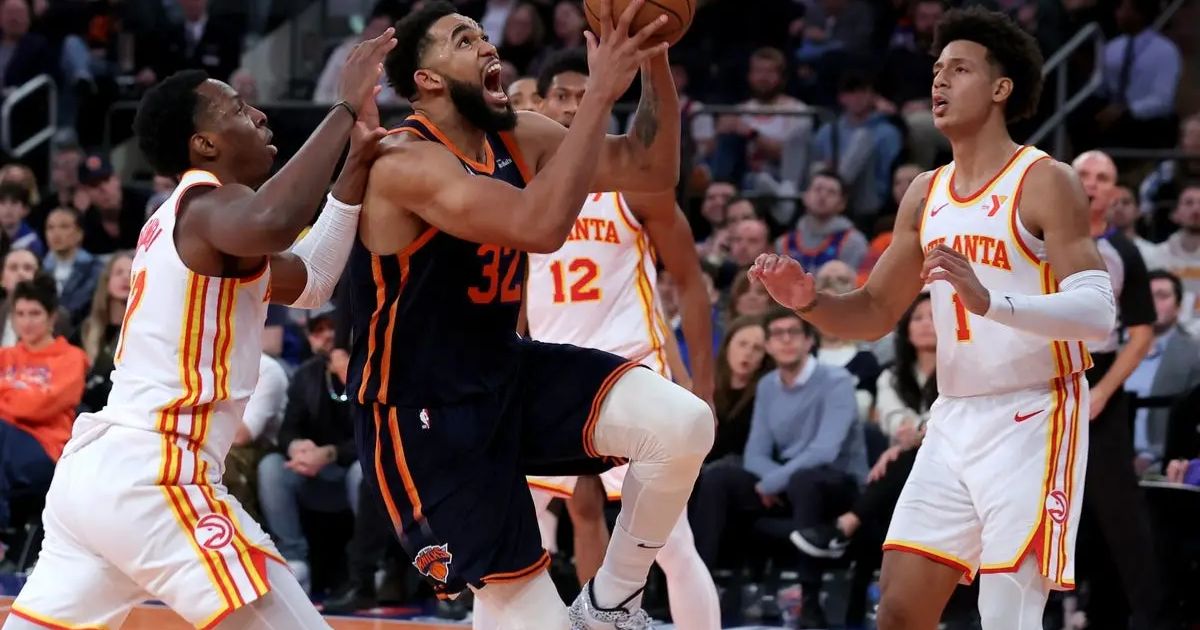The recent matchup between the New York Knicks and Orlando Magic delivered an electrifying display of basketball prowess, showcasing the talent and strategic depth of both Eastern Conference teams. This highly anticipated contest featured standout performances from key players on both sides, with the Knicks ultimately securing a hard-fought victory.
This comprehensive analysis breaks down the statistical narratives, tactical elements, and individual performances that defined this pivotal matchup in the NBA playoff race.
As both franchises continue their pursuit of postseason success, this game offered valuable insights into their strengths, weaknesses, and potential trajectories. From Julius Randle’s dominant showing to Paolo Banchero’s impressive counter-performance, this game highlighted why NBA game recaps between these two teams consistently captivate basketball enthusiasts.
Game Overview & Final Score
The New York Knicks emerged victorious against the Orlando Magic with a final score of 107-98, capping off a contest characterized by defensive intensity and offensive efficiency. The nine-point margin somewhat belies the competitive nature of this matchup, which featured several momentum shifts throughout four quarters of action.
The game’s defining characteristic was the Knicks’ ability to maintain composure during critical moments, particularly during the second half when their defensive schemes truly began to disrupt Orlando’s offensive flow. This victory strengthens New York’s position in the Eastern Conference standings while highlighting areas of improvement for a young Magic squad still finding its identity.
Coach Tom Thibodeau’s trademark defensive intensity was on full display, as the Knicks continuously pressured Orlando’s ball handlers and contested shots both in the paint and on the perimeter. Meanwhile, Coach Jamahl Mosley’s squad showed flashes of brilliance but struggled with consistency against the more experienced Knicks roster.
Key Highlights:
The game featured numerous compelling moments and statistical milestones:
- Halftime score stood at Knicks 54, Magic 47, reflecting New York’s early control
- Knicks established their largest lead at 18 points during a decisive run in the 3rd quarter
- Julius Randle emerged as the leading scorer with 30 points for New York
- Paolo Banchero led Orlando with an impressive 26-point performance
- The Knicks dominated the rebounding battle with a decisive 50-42 advantage
- New York’s defensive pressure forced 15 Magic turnovers, creating additional scoring opportunities
- The Knicks’ field goal percentage (47.3%) narrowly edged Orlando’s (45.1%)
- Critical free throws in the final quarter helped seal the victory for New York
Top Performers & Key Player Statistics
The matchup featured exceptional individual performances from players on both teams, with several athletes recording impressive statistical lines across multiple categories. These player stats not only impacted the game’s outcome but also reflect broader seasonal trends for both franchises.
New York Knicks’ Top Performers:
- Julius Randle: 30 points, 12 rebounds, 5 assists, 1 block
- Jalen Brunson: 22 points, 6 assists, 3 rebounds, 1 steal
- RJ Barrett: 18 points, 7 rebounds, 2 assists
- Mitchell Robinson: 10 points, 15 rebounds, 3 blocks
The Knicks’ balanced attack featured contributions from both their starting lineup and bench players, creating a multi-faceted offensive approach that proved difficult for Orlando to contain. Particularly noteworthy was New York’s interior dominance, with rebounding battles consistently won by Knicks players.
Orlando Magic’s Top Performers:
- Paolo Banchero: 26 points, 7 rebounds, 3 assists
- Franz Wagner: 18 points, 5 rebounds, 3 assists
- Markelle Fultz: 12 points, 6 assists, 4 rebounds
- Wendell Carter Jr.: 14 points, 9 rebounds, 2 assists
Despite the loss, the Magic demonstrated why their young core continues to generate excitement throughout the league. Paolo Banchero’s versatile scoring ability and Franz Wagner’s efficient two-way play provided glimpses of Orlando’s promising future, even as they struggled against New York’s disciplined defensive schemes.
Notable Stats Comparison:
| Player Name | Points | Rebounds | Assists | Steals | Blocks |
| Julius Randle | 30 | 12 | 5 | 1 | 1 |
| Paolo Banchero | 26 | 7 | 3 | 1 | 1 |
| Jalen Brunson | 22 | 3 | 6 | 1 | 0 |
| Franz Wagner | 18 | 5 | 3 | 2 | 0 |
| RJ Barrett | 18 | 7 | 2 | 0 | 0 |
| Markelle Fultz | 12 | 4 | 6 | 1 | 0 |
This box score comparison reveals the statistical proximity between certain matchups, particularly the Julius Randle vs. Paolo Banchero dynamic that emerged as a central narrative throughout the contest. While Randle’s more complete stat line ultimately proved more impactful, Banchero’s performance demonstrated why he remains a cornerstone of Orlando’s rebuilding efforts.
New York Knicks Player Stats
The Knicks team stats breakdown reveals a well-balanced attack complemented by stifling defense. Their collective effort on both ends of the floor exemplifies the identity that Coach Tom Thibodeau has carefully cultivated. The team’s defensive rating continues to rank among the league’s elite, while their offense has found greater consistency through established role clarity.
New York’s dominance on the glass (50 total rebounds) created additional possessions that proved crucial in maintaining their lead. Additionally, their ball movement (24 assists) reflected a cohesive offensive approach that generated high-percentage scoring opportunities throughout the contest.
Julius Randle: The Engine of the Knicks’ Offense
Julius Randle delivered a masterclass performance that reinforced his status as New York’s offensive centerpiece. His 30 points on efficient shooting (46% from the field, 38% from three-point range) demonstrated his evolution as a multi-level scorer capable of punishing defenses from various spots on the floor.
“Randle was a force tonight. His ability to score, rebound, and create for others makes him the complete package. When he’s playing at this level, he elevates our entire team,” noted Coach Thibodeau in the postgame press conference.
Beyond his scoring prowess, Randle’s 12 rebounds and 5 assists highlight his comprehensive impact on the game. His dominance was particularly evident during the 3rd quarter, where his 12-point eruption helped establish New York’s largest lead and effectively shifted momentum decisively in the Knicks’ favor.
His ability to draw defensive attention created opportunities for teammates, reflecting his growth as both a scorer and facilitator within the Knicks’ offensive system.
Jalen Brunson: Playmaker and Scorer
Jalen Brunson continues to demonstrate why his acquisition ranks among the Knicks’ most impactful recent moves. His 22-point, 6-assist performance against Orlando showcased his dual-threat capabilities as both scorer and facilitator. Brunson’s assist-to-turnover ratio remained impressive throughout the contest, reflecting his careful ball handling and decision-making under pressure.
Brunson’s impact extended beyond traditional statistics, as his floor generalship and pace control allowed New York to dictate tempo throughout crucial stretches. His midrange proficiency and ability to navigate pick-and-roll actions created consistent offensive advantages that Orlando struggled to contain.
His partnership with Randle has blossomed into one of the conference’s most formidable offensive duos, with complementary skill sets that force opposing defenses into difficult coverage decisions.
Mitchell Robinson: Dominating the Paint
Mitchell Robinson’s interior presence proved transformative for the Knicks’ defensive identity against Orlando. His 15 rebounds (including 6 offensive boards) and 3 blocks established him as the game’s premier rim protector and glass cleaner. Robinson’s ability to alter shots without fouling disrupted Orlando’s interior scoring plans throughout the contest.
His defensive impact was particularly evident against Wendell Carter Jr., who struggled to establish consistent post position against Robinson’s length and timing. Robinson’s 10 points, primarily generated through offensive putbacks and lob finishes, provided efficient supplementary scoring that further extended New York’s advantages.
Robinson’s development into an elite defensive anchor represents one of the most significant success stories in the Knicks’ recent player development program, with his presence fundamentally altering opponents’ offensive game plans.
RJ Barrett: Contributing Across the Board
RJ Barrett delivered a well-rounded performance with 18 points and 7 rebounds, providing crucial supplementary production within New York’s offensive framework. His scoring efficiency (7-of-15 shooting) and improved shot selection reflect his ongoing development as a complementary wing scorer.
Barrett’s defensive contributions, though less quantifiable in traditional statistics, proved equally important as he contested shots and navigated screens effectively throughout his minutes. His ability to guard multiple positions provided Coach Thibodeau with valuable defensive flexibility against Orlando’s versatile wing players.
As Barrett continues to refine his game, his evolving role within New York’s system demonstrates the depth and versatility that has fueled the Knicks’ competitive resurgence in the Eastern Conference.
Orlando Magic Player Stats
The Orlando Magic player stats tell the story of a talented young team still working to achieve consistent execution against established opponents. While individual bright spots emerged throughout the contest, their collective Magic player efficiency metrics revealed areas requiring further development.
Orlando’s defensive approach showed promise, particularly in forcing 12 Knicks turnovers, but their inability to capitalize on these opportunities limited their ability to mount a sustained comeback. The Magic’s youth and athleticism created periodic advantages, though these were often counterbalanced by execution errors in critical moments.
Paolo Banchero: Orlando’s Leading Scorer
Paolo Banchero reinforced his status as Orlando’s cornerstone talent with a dominant 26-point performance against New York. His diverse scoring arsenal—featuring post moves, perimeter shooting, and transition opportunities—highlighted why he represents the future of the franchise.
Banchero’s ability to create his own shot against quality defenders demonstrates advanced offensive development for a player of his experience level. His 7 rebounds and 3 assists further showcase his evolving all-around game and leadership qualities.
“Paolo continues to grow each game. His performance tonight against a physical, playoff-caliber defense shows why we’re so excited about his trajectory,” Coach Mosley remarked after the game.
While Banchero’s individual brilliance shone throughout the contest, his performance also revealed areas for continued growth, particularly in defensive consistency and late-game execution when facing elite opposition.
Franz Wagner: A Solid Second Option
Franz Wagner demonstrated his value as Orlando’s secondary scoring threat with an efficient 18-point performance. His 5 rebounds and 3 assists reflected his versatility beyond mere scoring, as he contributed across multiple statistical categories throughout his minutes.
Wagner’s ability to score both in transition and within structured half-court sets gives Orlando’s offense necessary flexibility. His growing chemistry with Banchero suggests a promising future partnership that could anchor the Magic’s offensive approach for years to come.
His defensive versatility, highlighted by 2 steals, provides additional value beyond his scoring contributions. Wagner’s continued development as a two-way wing represents a crucial component of Orlando’s long-term competitive vision.
Read This Post: Tragedy Strikes the Chrisley Family: Daughter Dies Unexpectedly
Markelle Fultz: The Playmaking Presence
Markelle Fultz showcased his playmaking abilities with 6 assists against just 2 turnovers, orchestrating Orlando’s offense through both transition opportunities and half-court sets. His 12 points and 4 rebounds complemented his distribution skills, creating a balanced offensive approach from the point guard position.
Fultz’s court vision and ability to navigate defensive pressure generated quality scoring opportunities for teammates throughout the contest. His understanding of tempo and situational awareness continues to improve as he accumulates experience within Orlando’s system.
While his 40% shooting efficiency indicates room for improvement in his scoring consistency, Fultz’s overall floor management provided stability for a young Magic roster against New York’s aggressive defensive schemes.
Wendell Carter Jr.: A Reliable Force Inside
Wendell Carter Jr. contributed 14 points and 9 rebounds in a solid if unspectacular performance against New York’s formidable frontcourt. His interior presence provided necessary balance to Orlando’s perimeter-oriented attack, though he struggled at times against Mitchell Robinson’s length and athleticism.
Carter’s ability to operate in pick-and-roll actions created periodic advantages, though New York’s defensive rotations often limited the effectiveness of these sequences. His midrange shooting touch added valuable floor spacing that complemented Orlando’s offensive structure.
His defensive positioning and communication showed improvement, though the collective rebounding differential ultimately favored New York in this crucial aspect of the game.
Team Performance Comparison
A comprehensive examination of team statistics reveals the margins that ultimately determined the game’s outcome:
| Team | Points | Field Goal % | 3-Point % | Rebounds | Assists | Turnovers |
| New York Knicks | 107 | 47.3% | 35.2% | 50 | 24 | 12 |
| Orlando Magic | 98 | 45.1% | 32.4% | 42 | 21 | 15 |
Key Observations:
The statistical comparison highlights several critical differentials that influenced the final result:
- The Knicks’ field goal percentage advantage (47.3% vs. 45.1%) reflected their superior shot selection and execution
- New York’s rebounding dominance (+8) provided crucial extra possessions, particularly on the offensive glass
- The Knicks’ 3-point shooting efficiency (35.2% vs. 32.4%) created necessary floor spacing for their offensive sets
- Orlando’s higher turnover count (15 vs. 12) resulted in missed scoring opportunities that proved costly
- While assist totals remained relatively close, New York’s superior assist-to-turnover ratio reflected more disciplined offensive execution
These statistical margins, while individually modest, collectively created the separation that allowed New York to maintain control throughout most of the contest.
Game-Changing Moments & Highlights
Several pivotal sequences fundamentally altered the game’s trajectory:
Julius Randle’s 3rd quarter surge transformed a competitive contest into a Knicks advantage, as his 12-point explosion during this period established New York’s largest lead at 18 points. His scoring variety during this stretch—featuring post moves, perimeter shooting, and transition opportunities—showcased his complete offensive arsenal.
Mitchell Robinson’s blocks in the second half repeatedly disrupted Orlando’s interior scoring attempts, with his third-quarter rejection of a Banchero drive particularly shifting momentum. These defensive highlights energized the Madison Square Garden crowd and further fueled New York’s surge.
The Knicks’ clutch free throw shooting in the final quarter (84% conversion rate) systematically extinguished Orlando’s comeback attempts. Jalen Brunson’s perfect 6-for-6 performance from the line in the game’s closing minutes exemplified New York’s situational execution.
Coaching Strategies & Adjustments
The tactical approaches employed by both coaching staffs significantly influenced the game’s flow and outcome:
Coach Tom Thibodeau’s defensive scheme emphasized pressuring Orlando’s ball handlers while maintaining disciplined rim protection. This approach disrupted the Magic’s offensive rhythm while generating transition opportunities through forced turnovers and contested shots.
“Our defensive identity starts with effort and communication. Tonight, I thought our guys were locked in on both counts, especially in the second half,” Thibodeau explained.
Thibodeau’s strategic use of timeouts to interrupt Orlando’s momentum runs demonstrated his game management expertise. His rotational patterns maximized New York’s defensive versatility while maintaining offensive spacing and creation.
Coach Jamahl Mosley countered with a pick-and-roll heavy approach designed to create mismatches against New York’s switching defense. While this strategy generated periodic advantages, the Knicks’ disciplined rotations and communication limited its sustained effectiveness.
Mosley’s substitution patterns prioritized development opportunities for young players while seeking workable combinations, though the team’s execution in crucial moments revealed the ongoing maturation process within this rebuilding program.
Injuries & Absences Impact
The game’s competitive dynamics were influenced by personnel availability, with Jonathan Isaac’s absence particularly impacting Orlando’s defensive versatility. Isaac’s length and multi-positional defensive capabilities would have provided valuable options against Randle’s offensive arsenal.
“We obviously miss Jonathan’s defensive presence, but this creates opportunities for other guys to step up. That’s been our approach all season,” Mosley noted pregame.
Both teams otherwise featured relatively complete rotations, with the established player combinations reflecting the continuity that both coaches have sought to develop throughout the season.
Fan & Media Reactions
The basketball community’s response to this contest reflected its competitive nature and individual performances:
Knicks fan reactions across social media celebrated Randle’s dominant showing and the team’s defensive intensity. The victory generated renewed optimism regarding New York’s positioning in the Eastern Conference playoff picture.
Basketball analysts highlighted the contrasting developmental stages of these franchises, with New York’s veteran execution ultimately prevailing against Orlando’s promising but still-evolving young core. Particular attention focused on the Julius Randle player stats and his impact during the decisive third-quarter stretch.
ESPN Knicks coverage emphasized the team’s improved offensive efficiency since the All-Star break, with this performance representing a continuation of that positive trend. Meanwhile, Orlando received praise for Banchero’s individual brilliance despite the collective result.
What’s Next? Future Implications
The victory strengthens New York’s position in the competitive Eastern Conference playoff race, with continued momentum potentially improving their eventual seeding. Their defensive identity and offensive balance suggest sustainability as they approach the season’s final stretch.
For Orlando, this loss represents a learning opportunity within their broader developmental arc. The continued evolution of their young core, particularly the Banchero-Wagner partnership, provides encouraging signs despite short-term competitive challenges.
The Knicks vs 76ers matchup looms as New York’s next significant test, while Orlando will seek to apply lessons from this defeat as they continue building organizational momentum under Mosley’s guidance.
Conclusion
The Knicks vs Orlando Magic contest delivered compelling basketball action while highlighting the contrasting trajectories of two Eastern Conference franchises. New York’s veteran execution and defensive discipline ultimately prevailed against Orlando’s youthful talent and potential.
Julius Randle’s complete performance anchored the Knicks’ victory, with complementary contributions from Brunson, Robinson, and Barrett creating a balanced attack that Orlando couldn’t consistently counter. Meanwhile, Banchero’s individual brilliance for the Magic offered glimpses of the franchise’s promising future.
As both teams continue their respective journeys—New York pursuing immediate postseason success while Orlando builds toward long-term contention—this matchup provided valuable context for evaluating their developmental progress and competitive positioning.
The statistical narratives, tactical elements, and individual performances combined to create a comprehensive picture of where these teams currently stand and where they might be heading as the NBA season progresses toward its conclusion.

Hello, I’m Ruby Ember, a writer at azaadlifestyle. I explore the dynamic world of players and celebrities, delivering captivating insights and updates. Join me on azaadlifestyle.com for the latest in player stats and celebrity news.

